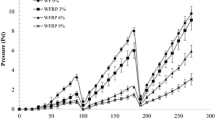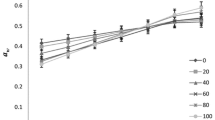Abstract
This study was investigated to evaluate the phenolic acid composition, antioxidant potential and acceptance of rusk prepared by the progressive replacement of wheat flour with barley flour. The wheat-barley blends rusks were also evaluated for their pasting and sensorial properties. The pasting characteristics of wheat flour was influenced by barley flour incorporation with a increase in peak and final viscosity values with increasing amount of barley flour. The results revealed that incorporation of barley flour into wheat flour improved the nutritional and bioactive compounds profile. The free radical scavenging activities towards DPPH and ABTS+ was found to be higher for wheat-barley blends rusk in comparison with wheat rusk. As evident from total phenolic content, total flavonoids contents and antioxidant activities, barley flour was found to be rich in bioactive compounds in comparison with wheat flour. Supplementation of rusks with 30% barley flour were suggested to be nutritionally superior with an acceptable sensory score and is a successful approach to enrich rusks with nutrients.


Similar content being viewed by others
References
Abdel-Aal ESM, Rabalski I (2013) Effect of baking on free and bound phenolic acids in wholegrain bakery products. J Cereal Sci 57(3):312–318
Altan A, McCarthy KL, Maskan M (2009) Effect of extrusion process on antioxidant activity, total phenolics, and β-glucan content of extrudates developed from barley-fruit and vegetable by products. Int J Food Sci Technol 44:1263–1271
Aludatt MH, Rababah T, Ereifej K, Alli I, Alrababah MA, Almajwal A, Masadeh N, Alhamad MN (2012) Effects of barley flour and barley protein isolate on chemical, functional, nutritional and biological properties of Pita bread. Food Hydrocoll 26:135–143
Angioloni A, Collar C (2011) Polyphenol composition and “in vitro” antiradical activity of single and multigrain breads. J Cereal Sci 53:90–96
Brand-Williams W, Cuvelier ME, Berset C (1995) Use of a free radical method to evaluate antioxidant activity. LWT-Food Sci Technol 28:25–30
Brennan CS, Cleary LJ (2005) The potential use of cereal (1/3), (1/4) β-D-glucans as functional food ingredients. J Cereal Sci 42:1–13
Chlopicka J, Pasko P, Gorinstein S, Jedryas A, Zagrodzki P (2012) Total phenolic and total flavonoid content, antioxidant activity and sensory evaluation of pseudocereal breads. LWT-Food Sci Technol 46:548–555
Dhull SB, Punia S, Sandhu KS, Chawla P, Singh A (2019) Effect of debittered fenugreek (Trigonella foenum graecum L.) flour addition on physical, nutritional, antioxidant and sensory properties of wheat flour rusk. Legume Sci Wiley. https://doi.org/10.1002/leg3.21
Dinis TCP, Madeira VMC, Almeidam LM (1994) Action of phenolic derivates (acetoaminophen, salycilate, and 5-aminosalycilate) as inhibitors of membrane lipid peroxidation and peroxylradicals scavengers. Arch Biochem Biophys 315:161–169
Fang Z, Hu Y, Liu D, Chen J, Ye X (2008) Changes of phenolic acids and antioxidant activities during potherb mustard (Brassica juncea, Coss.) pickling. Food Chem 108:811–817
Frost DJ, Adhikari K, Lewis DS (2011) Effect of barley flour on the physical and sensory characteristics of chocolate chip cookies. J Food Sci Technol 48:569–576
Gao L, Wang S, Oomah BD, Mazza G (2002) Wheat quality: antioxidant activity of wheat millstreams. In: Ng P, Wrigley CW (eds) Wheat quality elucidation. American Association of Cereal Chemists, St Paul, pp 219–233
Gawlik-Dziki U, Dziki D, Baraniak B, Lin R (2009) The effect of simulated digestion in vitro on bioactivity of wheat bread with Tartary buckwheat flavones addition. LWT-Food Sci Technol 42:137–143
Hernanz D, Nuñez V, Sancho AI, Faulds CB, Williamson G, Bartolomé B, Gómez-Cordovés C (2001) Hydroxycinnamic acids and ferulic acid dehydrodimers in barley and processed barley. J Agric Food Chem 49(10):4884–4888
Holtekjolen AK, Baevere AB, Rodbotten M, Berg H, Knutsen SH (2008) Antioxidant properties and sensory profiles of breads containing barley flour. Food Chem 110:414–421
Jia Z, Tang M, Wu J (1998) The determination of flavonoids content in mulberry and their scavenging effects on superoxides radicals. Food Chem 64:555–559
Lazaridou A, Biliaderis CG, Izydorczyk MS (2003) Molecular size effects on rheological properties of oat β-glucans in solution and gels. Food Hydrocolloid 17(5):693–712
Leenhardt F, Lyan B, Rock E, Boussard A, Potus J, Chanliaud E (2006) Wheat lipoxygenase activity induces greater loss of carotenoids than vitamin E during breadmaking. J Agric Food Chem 54:1710–1715
Lin MJY, Humbert ES, Sosulski FW (1974) Certain functional properties of sunflower meal products. J Food Sci 39:368–370
Liyana-Pathirana CM, Shahidi F (2007) Antioxidant and free radical scavenging activities of whole wheat and milling fractions. Food Chem 101:1151–1157
Mallik J, Kulkarni S (2010) Quality of rusks prepared by incorporation of concentrated whey. J Food Sci Technol 47:339–342
Manzocco LS, Calligaris S, Mastrocola D, Nicoli MC, Lerici CR (2000) Review of non-enzymatic browning and antioxidant capacity in processed foods. Trends Food Sci Technol 11:340–346
Moore J, Luther M, Cheng Z, Yu L (2009) Effects of baking conditions, dough fermentation, and bran particle size on antioxidant properties of whole wheat pizza crusts. J Agric Food Chem 57:832–839
Naczk M, Diosady LL, Rubin LJ (1985) Functional properties of colona meals produced by a two phase solvent extraction system. J Food Sci 50:1685–1688
Punia S, Sandhu KS, Siroha AK (2017) Difference in protein content of wheat (Triticumaestivum L.): effect on functional, pasting, color and antioxidant properties. J Saudi Soc Agric Sci. https://doi.org/10.1016/j.jssas.2017.12.005
Re R, Pellegrini N, Proteggente A, Pannala A, Yang M, Rice-Evans C (1999) Antioxidant activity applying an improved ABTS radical cation decolorization assay. Free Radic Biol Med 26:1231–1237
Sandhu KS, Punia S (2017) Enhancement of bioactive compounds in barley cultivars by solid substrate fermentation. J Food Meas Charact 11(3):1355–1361
Sharma P, Gujral HS (2014a) Antioxidant potential of wheat flour chapattis as affected by incorporating barley flour. LWT-Food Sci Technol 56:118–123
Sharma P, Gujral HS (2014b) Cookie making behavior of wheat-barley flour blends and effects on antioxidant properties. LWT-Food Sci Technol 55:301–307
Sosulski FW (1962) The centrifuge method for determining flour absorption in hard red spring wheats. Cereal Chem 39:344–349
Stevenson DG, Inglett GE, Chen D, Biswas A, Eller FJ, Evangelista RL (2008) Phenolic content and antioxidant capacity of supercritical carbon dioxide-treated and air-classified oat bran concentrate microwave-irradiated in water or ethanol at varying temperatures. Food Chem 108:23–30
Stojceska V, Ainsworth P, Plunkett A, Ibanoglu S (2009) The effect of extrusion cooking using different water feed rates on the quality of ready-to-eat snacks made from food byproducts. Food Chem 114:226–232
Xu B, Chang SKC (2008) Total phenolics, phenolic acids, isoflavones, and anthocyanins and antioxidant properties of yellow and black soybeans as affected by thermal processing. J Agric Food Chem 56:7165–7175
Yaqoob S, Baba WN, Masoodi FA, Shafi M, Bazaz R (2018) Effect of sprouting on cake quality from wheat–barley flour blends. J Food Meas Charact 12(2):1253–1265
Author information
Authors and Affiliations
Corresponding author
Additional information
Publisher's Note
Springer Nature remains neutral with regard to jurisdictional claims in published maps and institutional affiliations.
Rights and permissions
About this article
Cite this article
Punia, S., Sandhu, K.S. & Kaur, M. Quantification of phenolic acids and antioxidant potential of wheat rusks as influenced by partial replacement with barley flour. J Food Sci Technol 57, 3782–3791 (2020). https://doi.org/10.1007/s13197-020-04410-9
Revised:
Accepted:
Published:
Issue Date:
DOI: https://doi.org/10.1007/s13197-020-04410-9




